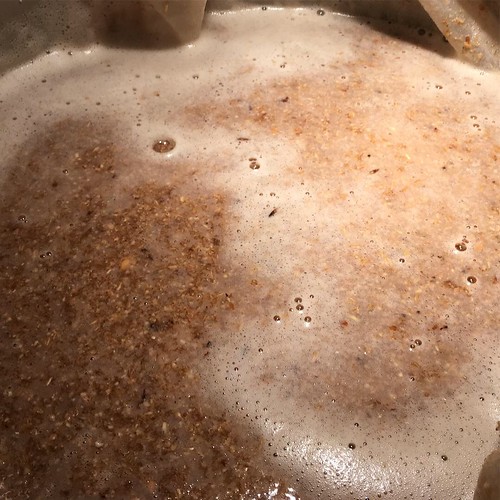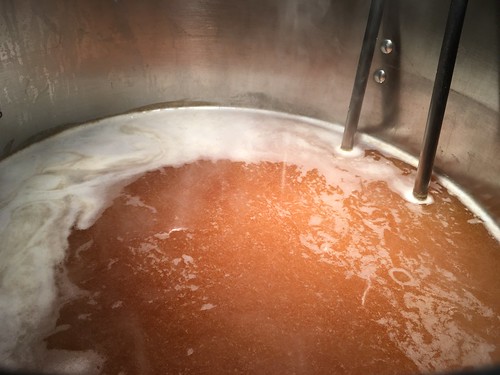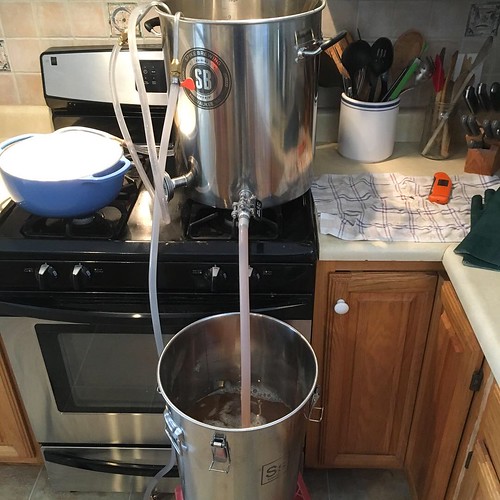Homebrew #78: Le Rousse (Ambrée Bière de Garde)
¶ by Rob FrieselAs we raced to the end of 2018, I wanted to fit in at least one more new-to-me style. I don’t know the Bière de Garde style well 1 but the description was intriguing. And while it isn’t much of a clever name, I haphazardly dubbed it Le Rousse 2– an ambrée bière de garde.

Given that I don’t know the style too well, I’ll readily admit that I cribbed heavily from some recipes I found. In particular, Gordon Strong’s recipe in Modern Homebrew Recipes and Josh Weikert’s on Craft Beer & Brewing. I wanted to brew one on the amber side, and dialed in my formulation accordingly.
Brew Day
As is my custom, brew day really started the night before — collecting my water and dosing it with minerals to achieve the profile I wanted. Bright and early the next morning though, I was milling and heating my strike water and mashing in and calibrating the pH meter etc.

I held the mash in the neighborhood of 152ºF for an hour, then decided to extend it by 15 minutes. Meanwhile, I was heating the mash out water, performing that infusion when the saccharification rest was otherwise completed. After pulling the bag and squeezing, I had approximately 7 gallons in the kettle at 1.057. 3

Proceed to boiling — 60 minutes on the stovetop, straddling two burners at full-blast — and add in the hops and candi syrup according to the schedule.
Post-boiling science gave me approximately 6.25 gallons after chilling at an original gravity of 1.064. 4 I ran off 5.5 gallons into the fermentor and pitched 200 ml of 1007 slurry (after decanting the supernatant) once the temperature was below 62ºF.

Fermentation
With the yeast pitched, I set the controller to 62±1ºF — only this fermentation wouldn’t stay there. After a little over two days at that temperature, I ramped it up to 63±1ºF. Then +1ºF after another 24 hours. And I kept doing this until I reached 69±1ºF. Once I hit that upper limit, I held it there for three days, whereupon I began to reduce the temperature 1ºF every 12 hours until I got back down to 62±1ºF.

Refractometer and hydrometer readings confirmed a final gravity of 1.010. I cold-crashed the beer, adding gelatin to fine after 24 hours at 34ºF. The beer sat with the gelatin for two days before I packaged it. Three 22 oz. bottles and seven 12 oz. bottles were primed with carbonation tablets (two each and one each, respectively) and set aside to bottle condition. The rest went into a keg which was put on 15 PSI for a couple of days.
Overall Impressions
I can’t rightly say if it’s a particularly good bière de garde, but I sure am enjoying it.

AROMA. Malt-forward. Medium intensity toffee and caramel supported by moderate toasted bread. Dark fruit elements include moderate raisin and mild dried cherry. Floral hop impression, albeit low. Low ester presentation like ripe red apple skin — otherwise clean. (Unless that dark fruit impression is ester-derived?) Alcohol is subtle in the nose, and comes out more as it warms. No observable diacetyl, nor DMS. [7/12]
APPEARANCE. Good clarity. Khaki head of moderately dense foam; great retention. Color is deep amber to copper (probably between 13-17 SRM?) with mahogany and ruby highlights. Color impressions are highly dependent on how the light strikes it. Flirting with being a brune example of the style. [3/3]
FLAVOR. Malt-forward impression again. Medium malty sweetness; medium intensity toffee and caramel. Low amounts of toasted bread, especially mid-palate. Light hop impressions, mostly toward the finish — floral, especially retronasally. Dark fruit impressions like moderate dried cherry and medium-low raisin. Soft, moderate bitterness. Off-dry finish with balance toward malt-sweet. Sweet impression does not hurt drinkability — semi-sweet aftertaste but doesn’t linger. [14/20]
MOUTHFEEL. Medium body but malty character gives impression of fullness. Medium carbonation. Mild alcohol warming. No perceptible astringency. Sweetness lends to impression of creaminess, but moderately so. [4/5]
OVERALL IMPRESSION. Very good (possibly excellent? 5) example of style. [34/50] Overall impression is of a malty, fairly alcoholic beer with good drinkability. Though it’s already quite smooth, 6 suspect some aging could smooth it out more. (Consider lagering a bit longer or cooler? 7) The malt profile lends to drinkability but also seems to lack some complexity? I believe a little some stronger “toast” character would better balance the “malty-sweet” and “dark fruit” that are otherwise prominent. [6/10]
I’ll be curious to see what this beer matures into, but I’m also enjoying it enough that I’ll probably crush my way through the keg. There are no obvious-to-me places to improve it. I’m curious to see what judges have to say about it. That said, I think my rash decision to swap in some Red X in place of the Munich probably hurt that toasty impression a bit.
Recipe
The all-grain (BIAB) recipe for Le Rousse (Ambrée Bière de Garde) is as follows:
Water Chemistry
Starting with the Champlain Water District profile as a base, carbon filter and add:
- 0.20 g/gal. gypsum
- 0.25 g/gal. calcium chloride
- 0.31 g/gal. Epsom salt
- 0.08 g/gal. sodium chloride (salt)
- 0.80 ml/gal. 88% lactic acid
| Ca | Mg | Na | SO4²- | Cl- | HCO3- |
|---|---|---|---|---|---|
| 51 | 12 | 16 | 75 | 62 | 67 |
Mash Grains
- 10 lb. BEST Pilsen malt
- 2 lb. BEST Vienna malt
- 8 oz. BEST Red X malt 8
- 8 oz. Dingemans Special B malt
Fermentables
1 lb. D-45 Amber Candi Syrup (15 min. late addition)
Hop Schedule
- 1 oz. Perle (60 min.)
- 1 oz. Styrian Goldings (5 min.)
Yeast
Wyeast 1007 German Ale (1700 ml starter)
Brew Day
- Collect 17.97 qt. water and heat to 165.7°F. Mash in; hold at 152.1°F for 75 minutes. Meanwhile, collect 12.00 qt. water and heat to 196.3°F; add this water to the main mash and hold for 10 min. to mash-out.
- Remove filter bag from water. Squeeze filter bag to extract as much liquid as possible for wort. No sparge. Pre-boil volume should be 6.54 gallons.
- Bring to a boil. Boil for 60 minutes; follow hop schedule as described above. Add D-45 candi syrup with 15 minutes remaining.
- Cool to 65°F as rapidly as possible. Post-boil volume should be approx. 5.5 gallons.
- Aerate wort; pitch 1007 yeast from starter.
- Start fermentation at 61°F.
Beyond Brew Day
- Allow fermentation to complete (approx. 2 weeks); start at 61°F but gradually ramp up to 70ºF and back down.
- Approximately 48 hours after pitching, increase temperature by 1ºF. Continue to raise the temperature 1ºF every 24 hours thereafter until reaching 69±1ºF.
- After reaching 69±1ºF, hold the temperature there for approximately 3 days.
- Lower the temperature 1ºF every 12 hours until reaching 61±1ºF.
- Cold crash for at least 48 hours; optionally fine with gelatin.
- Transfer to keg.
- Chill to 40°F and force carbonate to 2.8 volumes. (Apply 15 PSI for at least 4 days.)
- Enjoy!
Details
Le Rousse, an Ambrée Bière de Garde by Tilde Gravitywerks
| Original Gravity | 1.064 |
| Final Gravity | 1.010 |
| ABV | 7.2% |
| Attenuation | 83.7% |
| IBU | 22 |
| SRM | 14 |
| Links | Flickr |
- Straightforward examples are hard to find around here, as our study group discovered last year.[↩]
- Confession: this beer was marked in Evernote for months as “???????? – Bière de Garde” and I almost named it “Literal French Flag Emoji” or something like that.[↩]
- A brief aside about the pre-boil gravity: I wound up polling friends from the local homebrew club about instruments and techniques for this measure, because I was getting numbers that didn’t agree and didn’t add up. A refractometer reading gave me 1.050. A hydrometer reading gave me 1.057. BeerSmith had estimated 1.055, so I went with the latter. The 60 minute boil with my typical stovetop evaporation rate should have given me 5.9 gallons at 1.067 — plus 0.006 from the candi syrup for 1.073 — which would have been above the estimated 1.068 O.G. Fast-forward to the actual O.G. however, and I measured 1.064 — which would be more consistent with the refractometer’s measurement. That said, my boil-off rate was also quite a bit lower than anticipated, and I wound up with 6.25 gallons in the kettle after chilling. So seems to me that the truth is somewhere between those two instruments, but I haven’t the patience to work out exactly what’s what.[↩]
- Again: not the numbers I was expecting, but see the previous footnote for that particular rant.[↩]
- Again: I’m not super-familiar with the style, making it a hard one to judge. And the style guide seems to leave a fair room for interpretation.[↩]
- Weikert says the style doesn’t really need aging, despite what’s implied from the name.[↩]
- Let’s be honest here: I really didn’t lager in the practical sense.[↩]
- I originally had this as 8 oz. of Munich — but I got into an enthusiastic conversation at the local HBS about Red X and… well, I keep telling myself that they’re similar enough.[↩]
About Rob Friesel
Software engineer by day. Science fiction writer by night. Weekend homebrewer, beer educator at Black Flannel, and Certified Cicerone. Author of The PhantomJS Cookbook and a short story in Please Do Not Remove. View all posts by Rob Friesel →3 Responses to Homebrew #78: Le Rousse (Ambrée Bière de Garde)
Pingback: Homebrew #81: Half Dark | found drama
Pingback: Rob Friesel and his Bière de Garde - Stone Corral
Leave a Reply